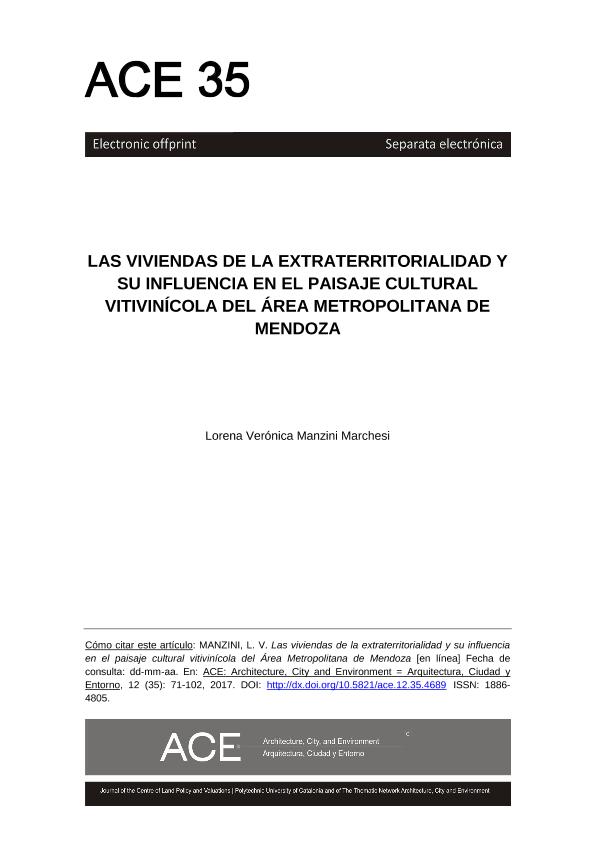Artículo
En la actualidad, el Área Metropolitana de Mendoza (AMM) posee un crecimiento urbano y habitacional “extraterritorial”, vertiginoso, dinámico y espontáneo, producto de una carente planificación del estado, quedando a la deriva de la oferta y demanda de la especulación inmobiliaria. El resultado está vinculado al proceso de metropolización del territorio y se observa en especial en los sectores rurales y periurbanos - interface. Las viviendas extraterritoriales integradas por los barrios privados y villas de emergencia son producto de la falta de planificación del estado a cargo y se rigen por un estado de excepción descontextualizados de los recursos y sistemas estructurante del entorno. Los barrios privados son los que tienen mayor influencia en los terrenos de cultivo contribuyendo a la banalización del paisaje vitivinícola atentando contra el carácter identitario y su potencial como recurso colectivo. Ante ello, el objetivo del presente trabajo propone, desde el marco de la conservación patrimonial, realizar un estudio histórico arquitectónico que analice los barrios privados y como estos están banalizando el paisaje cultural del AMM. La metodología aplicada conjuga la historia, la arquitectura y la geografía y hace factible analizar el paisaje del vino como patrimonio. El principal aporte del trabajo radicó en que la mirada histórica sobre el paisaje permitió detectar la vivienda de la extraterritorialidad como un producto de la metropolización del territorio y su influencia negativa en el carácter del paisaje vitivinícola. Contribuyendo de esta manera, al conocimiento de base a tener en cuenta en las tomas de acción en el territorio por los diversos actores públicos y privados vinculados. At present, the Metropolitan Area of Mendoza (AMM) has an urban and extraterritorial urban growth, vertiginous, dynamic and spontaneous, product of a lacking planning of the state, remaining adrift of the supply and demand of real estate speculation. The result is linked to the process of metropolitanization of the territory and is observed especially in the rural and periurban sectors - interface. Extraterritorial housing integrated by the gated communities and slums are product of the lack of planning of the state in charge and they are governed by a state of exception decontextualized of the resources and systems structuring the territory. Gated communities have the greatest influence on landscape, contributing to the banalization of the vineyard landscape, against the identity character and its potential as a collective resource. In view of this, the aim of this work proposes, from the framework of patrimonial conservation, to carry out a historical architectural study that analyzes the gated communities, and how they are banalizing the cultural landscape of the AMM. The applied methodology combines history, architecture and geography and makes it feasible to analyze the vineyard landscape as heritage. The main contribution of the work was that the historical view on the landscape allowed to detect the housing of extraterritoriality as a product of the metropolization of the territory and its negative influence on the character of the vineyard landscape. Contributing in this way, the basic knowledge to be taken into account in the actions taken in the territory by the public and private actors linked.
Houses of extraterritoriality and its influence in the vineyard landscape of the metropolitan area of mendoza
Título:
Las viviendas de la extraterritorialidad y su influencia en el paisaje cultural vitivinícola del área metropolitana de mendoza
Fecha de publicación:
10/2017
Editorial:
Universitat Politecnica de Catalunya
Revista:
Architecture, City and Environment
ISSN:
1886-4805
Idioma:
Español
Tipo de recurso:
Artículo publicado
Clasificación temática:
Resumen
Archivos asociados
Licencia
Identificadores
Colecciones
Articulos(INCIHUSA)
Articulos de INST. DE CS. HUMANAS, SOC. Y AMBIENTALES
Articulos de INST. DE CS. HUMANAS, SOC. Y AMBIENTALES
Citación
Manzini Marchesi, Lorena Verónica; Houses of extraterritoriality and its influence in the vineyard landscape of the metropolitan area of mendoza; Universitat Politecnica de Catalunya; Architecture, City and Environment; 12; 35; 10-2017; 71-102
Compartir
Altmétricas




